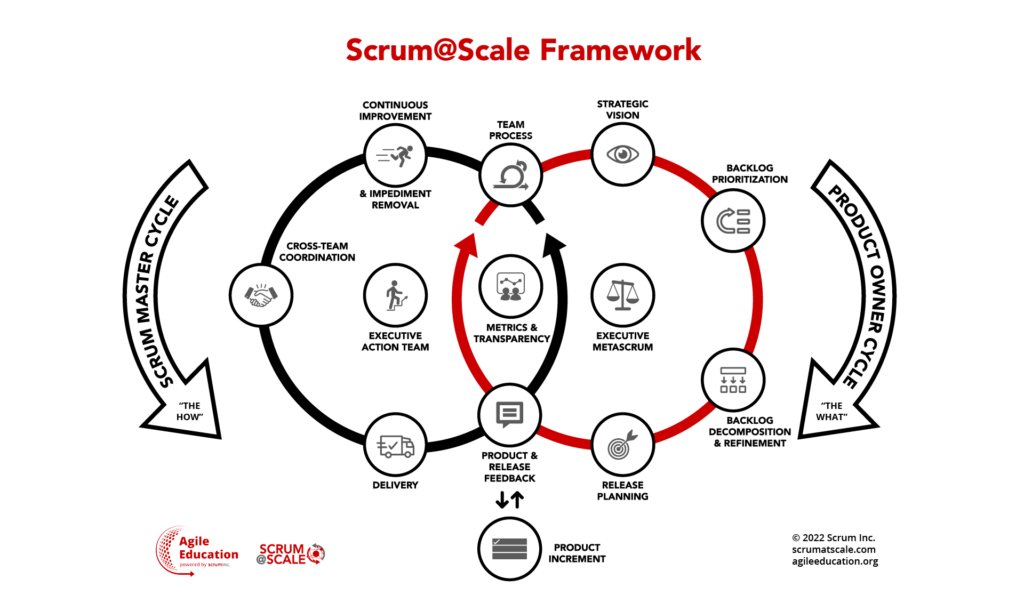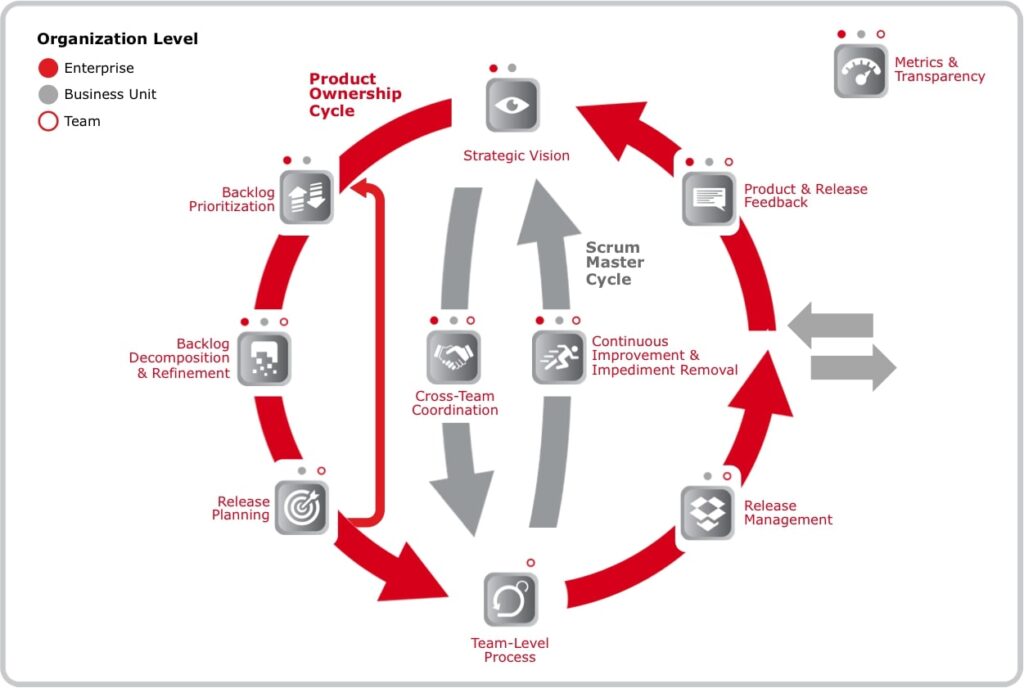Scrum@scale provides a lightweight, transformative framework that allows organizations to adapt themslves to many scenarios that present themselves during project development. This transformation enables Scrum teams to handle communications and create strategic priorities to help meet deliverables within the budget limitations.
At first glance, understanding Scrum@Scale is overwhelming. However, if you are reading on, chances are you are looking to explore further.
Smart choice.
This guide breaks down the core concepts and various components of Scrum@scale that you must be mindful of to implement this framework in your organization.
Let’s dive in.
What is Scrum@Scale?
Scrum@scale is an extension of the Scrum framework that empowers organizations to follow a standard structure for their systems and processes to achieve organic growth. This organic growth depends on the unique conditions within the organization that facilitate the delivery of results. This definition by Dr. Jeff Sutherland, the co-creator of Scrum, highlights the significance of Scrum@scale for creating an ecosystem where everyone is responsible for transforming the organizational culture.

Credits: Scrum Inc
Before we delve further into Scurm@scale, let’s first understand how Scrum impacts teams and why Scrum@scale differs from traditional Scrum.
We know that the original Scrum framework focuses on consistent performance and collaborate by way of small teams that deliver small-scale projects. However, over the past few years, we have seen how Scrum implementation is responsible for reshaping the software development landscape. The core benefits of Scrum support faster decision-making, rapid development, and efficient performance by teams dealing with testing, iterations, alterations, and cross-team dependencies.
When organizations grow, the projects and their deliverables are much larger, and striving for simultaneous management of several Scrum projects is challenging. But having several individual teams working on various Scrum projects does not guarantee success. Managing multiple Scrum teams is easier said than done. This is where scaling Scrum is helpful, as it replicates all the critical benefits of Scrum guides in addressing complex adaptive problems while delivering superior quality products.
Scrum@scale guide specifies the minimum components to scale Scrum to promote business agility in the entire organization. Because the focus is on various aspects of the organization like systems, networks, and teams, Scrum@scale is ideal for organizations to customize their transformation strategy and prioritize efforts from the most valuable to the lesser valuable factors. Likewise, adopting Scrum@scale refines the organization’s culture by increasing accountability and eliminating conflicts that prevent teams from achieving immense high-level productivity and success.
Scrum@Scale Core Concepts
Scrum@scale comprises three core concepts:
- Working with small teams to help reduce complexity in the process.
- Focusing on linear scalability to determine successful scaling across the entire organization and increase the likelihood of success.
- Applying minimum viable bureaucracy to ensure lesser time in decision-making and execution.
Tips on Scaling Scrum
At first, if you opt for Scrum scaling, your organization must focus on adopting the Agile mindset in their operations. In general, scaling creates a network of teams, so developing a reference model to direct your scaling necessities is essential. This reference model comprises a set of teams that coordinate with one another on the deliverables for every Sprint. Such reference models are also helpful for the rest of the organization to follow the pathway for replicating the success of Scrum.

Credits: Scrum Inc
That said, issues arise when multiple teams adopt Scrum due to discrepancies in policies, procedures, and other development approaches that restrict the progress and performance. In a Scrum@scale setting, the reference model guides various teams coordinating on delivering increments into the Scrum of Scrums (SoS).
Considering Scrum of Scrum is essential for operational efficiency, a critical component in achieving it is with minimum viable bureaucracy, including two primary leadership groups: an Executive MetaScrum group focuses on the production aspect of Scrum of Scrums, whereas the Executive Action Team emphasizes how to achieve them faster.
Scaling Scenarios of the Teams
Scrum of Scrums includes multiple teams that focus on the production phases with the ideals of the Scrum guide. Each team in the scaled scenario must satisfy specific processes under the Scrum guide, such as:
- Maximizing the workflow to deliver complete work.
- Enhance performances of the teams over time.
- Maintaining a sustainable pace to elevate team performance.
- Accelerating the customer feedback and response mechanism.
Scrum of Scrums (SoS)
Scrum of Scrums is a critical component of Scrum@scale. This name suggests that a Scrum comprises smaller Scrums with similar characteristics to a regular Scrum. But there are additional roles that are part of Scrum of Scrums, such as representatives of each team who attend the daily Scrums. These teams are responsible for fulfilling the team process components like accountabilities, events, or artifacts. Apart from that, Scrum of Scrums involves a dynamic group; therefore, team sizes must remain within the optimal range of 4-5 members. In addition, these teams perform the most valuable process of delivering shippable increments at the end of the Sprint cycle.
Scrum Master Cycle
Not only does the name suggest Scrum Master, but these professionals represent leadership roles. The Scrum Master of SoS is known as the Scrum of Scrums Master (SoSM). They are an integral part of the Scrum@scale setup, ensuring higher productivity throughout the events. Scrum of Scrum Masters facilitate resources, direct collaborative team efforts, and aim for continuous improvement to improve overall performance. That said, these individuals identify alternative approaches to help achieve the deliverables at lower costs and maintain superior quality of end products.
A Scrum of Scrums Master is the leader and intermediary who works with the Chief Product Owner, coordinates with teams about the release plans, and addresses various operational challenges. In the same way, they also ensure proper prioritization of resources, maintain cross-team dependencies with clear communication, and track the product development progress at regular intervals during development.
The Product Owner Cycle
Similar to Scrum, different teams share a common backlog for each Scrum of Scrums. It involves the Product Owner Team and a Chief Product Owner who acts as the sole Product Owner for the various groups. The Product Owner prioritizes the tasks during the Sprint backlog to meet the objectives within the timeline. Some of the top priorities of the Product Owner Team include:
- Communicating the vision for the product development.
- Prioritizing backlog items.
- Creating a uniform “Decision of Done” that applies to all the teams.
- Creating a roadmap for the release planning.
- Monitoring various metrics to generate insights about the product and the market.
- Minimizing dependencies raised by the teams.
Scrum@Scale Roles
Bearing that the Scrum@Scale follows the Scrum guide, the roles of the Product Owner and the Scrum Master have similar competencies. At the same time, the Scrum Master manages the Daily Scrum and Retrospective when scaling Scrum. Likewise, the Product Owner is responsible for all the Sprint Reviews and Backlog Refinements under the Chief Product Owner’s (CPO) guidance. But when it comes to Sprint planning, the Product Owner and the Scrum Masters work together to create the Sprint goals.
These roles share some similarities. Yet, that’s not all. While the Product Owner Team focuses on the deliverables from the current Sprint, the Scrum Masters use insights to understand the technical capabilities necessary for delivering the end product. But both these roles translate to leadership roles to motivate various groups to adhere to the components of Scrum@Scale when working on the deliverables for respective Sprint cycles.
The Scaled Events
Not only does Scrum@Scale change the Scrum roles but it also impacts the Scrum events that need to scale to define various accountabilities. While a Daily Scrum highlights the progress towards the Sprint goal, the Scaled Daily Scrum (SDS) requirs discussions to understand collective progress and provide responses on how to address a specific challenge to the participating teams. However, these Daily Scrum are of shorter duration, and only representatives of each group attend them. Some SDS discussions involve effective coordination, tracking the work progress, understanding what needs to be done, and identifying the problem areas and the potential solutions. Moreover, an SDS optimizes the joint efforts and performance to help achieve the Sprint goals.
On the other hand, the Scaled Retrospective represents the scaled version of this Sprint Retrospective, where the Scrum Masters of the teams discuss various experiments that facilitate continuous and successful improvements.
Scrum@Scale Takeaways
With constant deadlines, budget constraints, and accountability to stakeholders, an organization must not follow a basic roadmap and hope to deliver end products. You must make quicker decisions with a strategic vision to respond to the market changes, user needs and aim for continuous innovation to meet customer commitments
Adopting the Scrum@scale framework allows an organization greater agility to deliver high-impact products to the market. Scrum@scale creates well-functioning Scrum teams that focus on building sustainable complex products by practicing Scrum values. While Scrum is applicable at a team level, it is also effective for the entire organization across various departments. But implementing Scrum@scale requires good Scrum practices and developing the mindset before scaling. As a result, frameworks like Scrum@Scale are practical options that enable enterprises to stay on the course of the organizational vision and grow at an organic pace with effective communication and coordination between a wide range of Scrum teams to achieve business objectives.